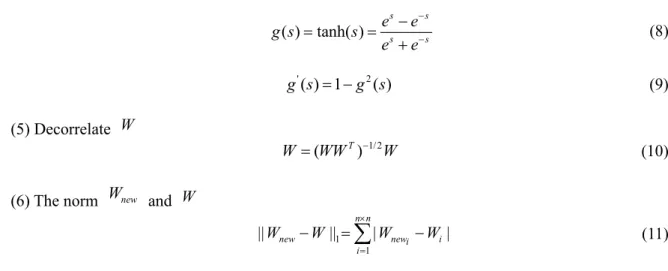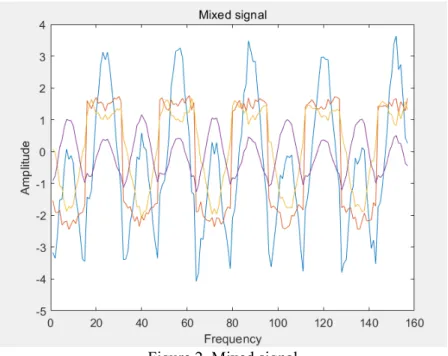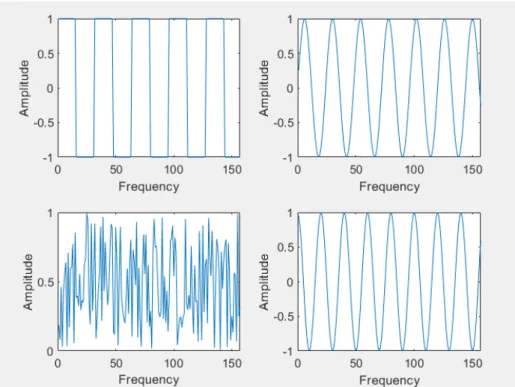PAPER • OPEN ACCESS
Based on multi-antenna multi-channel wireless signal separation
To cite this article: Yongji Zhao et al 2021 J. Phys.: Conf. Ser. 1738 012038
View the article online for updates and enhancements.
Based on multi-antenna multi-channel wireless signal
separation
Yongji Zhao1, Wenwen Hu2 and Kuilin Chen1*
1 Gansu Radio Monitoring Station, Lanzhou, Gansu, 730000, China
2 Lanzhou Radio Monitoring Station Monitoring Station, Lanzhou, Gansu, 730000,
China
*Corresponding author’s e-mail: zhyftxx@mail.lzjtu.cn
Abstract. Wireless signal separation under the condition of multi-antenna and multi-channel reception is a process of estimating the source signal component by using the observed signal vector. Under the condition of multi-antenna and multi-channel reception of wireless mixed signals, in view of the problem that the stability of FastICA algorithm will be affected, it is proposed to increase the number of iterations to improve the FastICA algorithm. The experimental comparison and simulation results of FastICA algorithm and FastICA improved algorithm It shows that for the separation of wireless mixed signals, the improved FastICA algorithm can achieve a better separation effect.
1. Introduction
With the rapid development of wireless communication technology, various wireless communication services have grown rapidly. In recent years, various communication signals have flooded the sky, and a large number of mixed wireless signals have appeared [1]. The mixed wireless signal here is aliased in
both the time domain and the frequency domain. At this time, it is difficult to realize the separation and demodulation of the mixed signal by using the traditional single-signal processing method. Therefore, the mixed signal processing technology has emerged [2]. Various wireless communication systems are
constantly emerging, users have higher and higher requirements for wireless communication data transmission rates, and the wireless electromagnetic environment has become increasingly complex. However, the spectrum resources available in practice are very limited. How to improve spectrum utilization under limited bandwidth conditions has always been a research hotspot and research difficulty in the field of communications [3].
Since the 1980s, mixed-signal processing technology has received extensive attention from researchers. It has gradually become a research hotspot in the signal field, and its ultimate goal is to achieve mixed-signal separation. Because the processing algorithms for mixed signals of different modulation types are not the same, mixed signal processing first needs to accurately identify the type of mixed signal in order to provide a decision basis for subsequent mixed signal processing [4]. In addition,
the accuracy of the mixed signal parameter estimation is also an important factor affecting the separation performance. Mixed signal processing mainly includes three key technologies: mixed signal identification, mixed signal parameter estimation, and mixed signal separation.
FastICA algorithm is a fast-Independent Component Analysis (ICA) algorithm, but it is an algorithm based on Newton's iterative method and reasonable approximation, so it has room for improvement. In recent years, many improvements have been proposed with higher-order convergence Properties of
2
Newton's iterative method [5]. A newton iterative method with third-order convergence is introduced into
the derivation of the ICA algor ithm. Based on a reasonable approximation, an improved two-step iterative FastICA algorithm is proposed [6]. Compared with the traditional FastICA algorithm, the calculation amount of one iteration of the proposed improved FastICA algorithm has increased. However, the experimental results show that the newly proposed improved FastICA algorithm is more robust and has a faster convergence rate in the separation of multi-antenna and multi-channel wireless signals.
2. Hybrid wireless signal model
The mathematical modeling of the multi-antenna and multi-channel received linear aliasing signal model can be expressed as
1 y( ) K i i( ) ( ) i t A x t n t
(1) Where x ti( ) is the signal to be identified falling into the channel, Ai is the amplitude of x ti( ),i=1, 2, ..., K, and n t( ) is additive noise. In order to facilitate analysis and discussion, this article defines ( )
i
x t as a sine signal, a cosine signal, and a square wave signal.
The sine signal model is
1( ) 1sin( * 1)
x t B t (2) The cosine signal model is
2( ) 2cos( * 2)
x t B t (3) 3 Improved FastICA algorithm and separation process
3.1 Improved FastICA algorithm
The optimization process of the traditional FastICA algorithm is realized by the classic Newton method. The optimization process is a second-order convergence process. In order to better improve the convergence order of the Newton method, and at the same time improve the efficiency of the Newton method to solve nonlinear equations, in recent years, many scholars have researched and proposed a series of modified Newton iterative algorithms for solving nonlinear equations.
The improved algorithm in this paper uses the non-discrete mathematical induction method to iteratively analyze the problem of solving nonlinear equations in Banach space, optimize the iterative process, modify the classic iterative algorithm, and propose two newton third-order convergences with simple operation and stable convergence. footwork:
* 1 ' * 1 1 ' ( ) ( ) ( ) ( ) ( ) n n n n n n n n n f x x x f x f x f x x x f x (4) Assuming sequence
xn converges to x*, and f x( ) is resolved in the neighborhood of x*,the convergence order k of the iterative algorithm satisfies the condition: j
0,
1, 2, ,
1;
k0.
f
x
j
k
f
Therefore, the non-discrete mathematical induction method is used to make a detailed analysis of the convergence properties. First, the univariate function f x( ) is used to prove that (4) has the third-order convergence property, and then this property is extended to the multivariate function, and the iterative formula is proved through analysis (4) For multivariate functions, the third-order convergence is also valid.
Specific steps are as follows:
Centralize the observation data so that its mean value is 0 to obtain x. Whitening pretreatment to obtain p.
Choose the number m of independent components to be estimated and set k1. Initialize the vector wk with unit norm.
Set n1, wk, use formula (5) (6) to update wk.
* ' 1 ( ) ( ) T T k k k w E pg w p E g w p (5)
*
'
* 1 ( ) ( 1 ) ( ) 1 T T T k k k k k k w E pg w p E pg w p E g w p w w (6)a) Perform Gram-Schmidt orthogonalization:
1 1 ( ) k T k k k j j j w w w w w
. b) Standardize wk, namely: || || k k k w w w .c) The convergence condition is defined as the infinite norm of wk is less than
10
6 . If kw does not converge, n n 1, return to step (e). d) Set k k 1, if k m , return to step (d).
3.2 Separation process
(1) Normalized
First, normalize the observation data
x
, that is, subtract its mean m E {x} to make it have a zero mean. This means that s is also zero mean. Normalization preprocessing can simplify the algorithm. After the normalized mixing matrix A is estimated, the calculated separated signal s is added to the mean value A m1 of s.(2) Albino
After normalization, the observation vector x is linearly transformed so that its components are uncorrelated and have unit variance, that is, whitened into a new vector x', whose covariance matrix is
equal to the identity matrix: E x x{ ' 'T}I A commonly used whitening method characterizes the data
covariance Eigen-Value Decomposition (EVD), namely {E xxT}EDET, where E is the orthogonal
matrix of the eigenvectors of E xx{ T} , D is the diagonal matrix of its eigenvalues, and
1
( ,..., )n
D diag d d . Therefore, the whitening operation can be written as x'ED1/2ETx , where
1/2 1/2 1/2
1
D diag d( ,...,dn )
. In the same way, the whitened mixed matrix gets
A , then A is orthogonal.
The whitening operation can reduce the parameters to be estimated. Estimating matrix A needs to estimate n2 parameters, while estimating orthogonal matrix A' only needs to estimate n n( 1) / 2
parameters, which greatly reduces the computational complexity of the algorithm. (3) InitializeW
n n
W R , random number fills n2 elements in W .
(4) W Update rules Assume S WZ ' { ( ) T} { ( )} new W E g s Z E g s W (7) Where g s( ) is the CDF of S. Select here
4 ( ) tanh( ) s s s s e e g s s e e (8) '( ) 1 2( ) g s g s (9) (5) Decorrelate W 1/2 ( T) W WW W (10)
(6) The norm Wnew and W
1 1 || new || n n| newi i| i W W W W
(11)4. Simulation results and analysis
Assume that the mixed signal received at the receiving end with multiple antennas and multiple channels consists of a sine signal, a cosine signal and a square wave signal. We conducted simulation experiments on the improved FastICA algorithm and FastICA algorithm proposed in this paper. In the experiment, a sine signal, a cosine signal and a square wave signal are selected, a noise signal is randomly generated, and the four signals are mixed to separate the mixed signals.
Figure 2. Mixed signal
The FastICA algorithm and the improved FastICA algorithm are used to separate wireless mixed signals. Through the separation result, compare whether the improved FastICA algorithm has better separation effect than FastICA algorithm.
6
Figure 4. Improved FastICA algorithm separation results
Through the separation results, we can clearly see that the improved FastICA algorithm is closer to the source signal, whether in amplitude or phase, and the improved FastICA algorithm has a better separation effect.
5. Conclusion
This paper focuses on the problem of wireless number separation, and proposes signal separation based on the improved FastICA algorithm. By comparing the separation results with the FastICA algorithm, a communication mixed signal experiment is carried out on the Matlab platform. The experiment shows that compared with the FastICA algorithm In the case of little difference in running time, the improved FastICA algorithm can improve the stability of the algorithm, and the separation of the improved FastICA algorithm has a better separation effect, can be closer to the source signal, and has a broader application prospect.
References
[1] Lian J, Xin H, Wang L. Simulation of blind source separation method for multipath channel digital intermediate frequency signal[J]. Computer Simulation, 2019, 36(06): 190-193.
[2] Xiong T. Research on the key technology of single-channel blind separation of co-frequency mixed signals [D].
[3] Pang L. Research on the separation method of time-frequency aliasing digital communication signal received by single antenna [D]. 2016.
[4] Wei P. Separation and Recognition of Co-channel Overlapping Multiple Signals[J]. Communication Countermeasures, 2005(01): 5-10.
[5] Wang J, Zhang L, Zhong Z. Blind source separation based on FastICA algorithm[J]. Computer Technology and Development, 2011(12):99-102.
[6] Zhu L, Zhao F. Application of an improved FastICA algorithm in blind source separation of speech signals[J]. Electroacoustic Technology, 2019(5).
[7] Liu Q. Design and implementation of Android-based wireless signal detection APP [D].
[8] Ren Z. Multi-antenna array signal blind separation technology in shallow water[J]. Ship Science and Technology, 2016, 38(10): 73-75.
[9] Jiang B, Yin Q, Jin L. Semi-blind closed separation method of multi-user co-channel signals[J]. Journal of Electronics and Information, 2001(06):521-527.
[10]Zhao Q, Hu B, Ling X. Blind separation of multi-user digital signals in non-ideal channels [J]. Acta Electronics, 1999(01): 3-5
[11]Luo Jun. Research on signal processing technology based on multi-antenna in cognitive radio[D]. Central China Normal University, 2017.
[12]Tang R, Wu H, Zhao Y, Mu W, Xu X, Ma X, Liu B, Liu Z. FPGA design of real-time blind separation of AIS multi-cell co-frequency signals[J]. Chinese Journal of Electronics, 2017, 45(09) :2121-2126.
[13]Xu T. A signal separation technology with the same frequency [J]. Electronic Technology, 1987(8): 7-8.
[14]Lu D, Chen T. Single-antenna ADS-B interlaced signal self-detection and separation algorithm based on EMD[J]. Signal Processing, 2019, 35(10): 1680-1689.
[15]Liu W, Li Y, Huang X, et al. Application of FastICA-based blind source separation algorithm in relative dielectric loss monitoring system [J]. High Voltage Apparatus, 2010(02): 86-90. [16]Zhang J. FastICA algorithm research and its application in speech signal separation [D]. 2013. [17]Chen Z. FastICA algorithm and its application in blind separation of communication systems[D].


